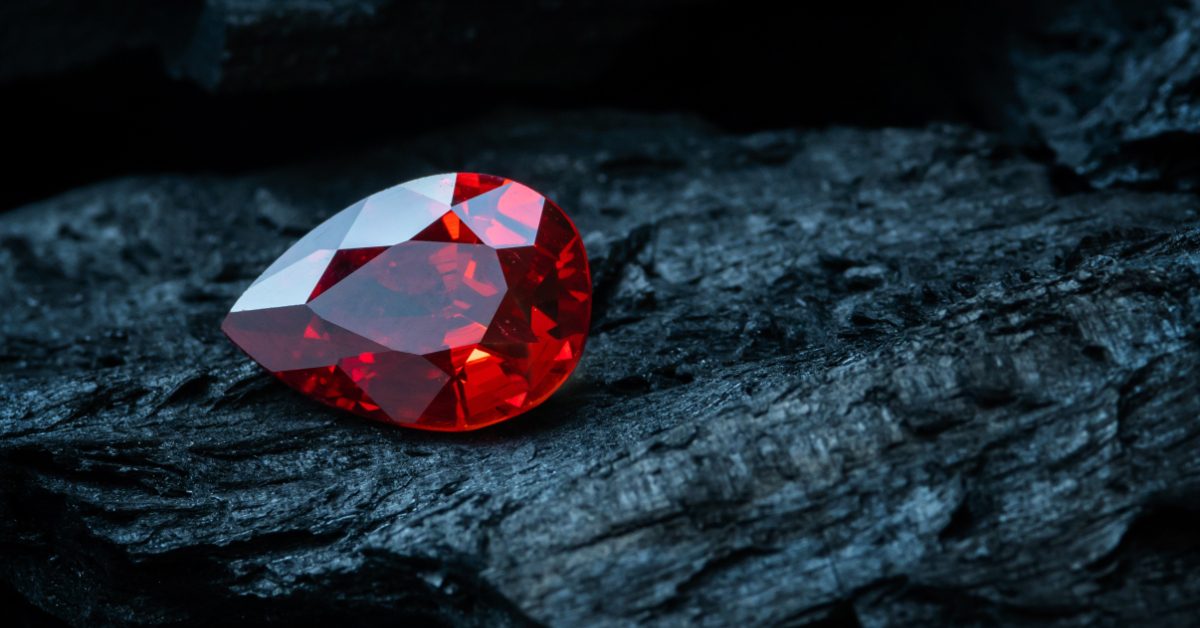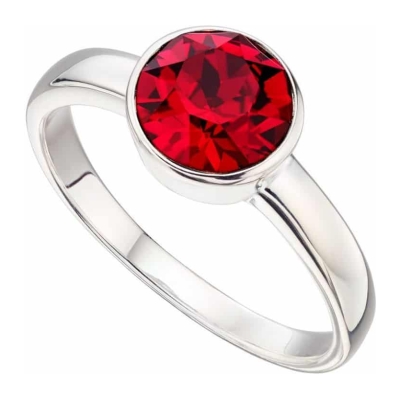Rubies are one of the best-known gemstones, famous for their stunning fiery appearance, and they are also the July birthstone. Pinkish-red or bright red in hue, Rubies form from corundum, a mineral. In fact, only red corundum is called “Ruby”, all other colours of corundum are known as “Sapphire”. Interestingly, ancient Oriental people believed that a Ruby was a ripe Sapphire, and if a Sapphire stayed buried in the Earth for long enough it would turn into a Ruby!
A very hard mineral, corundum has a rating of 9 on the Mohs hardness scale, so Rubies are durable and tough – ideal for any piece of birthstone jewellery that will be worn regularly. Only Diamonds are harder than Rubies.
The red fluorescence of Rubies, paired with their strength, makes them valuable for all kinds of applications as well as in the jewellery industry. Both synthetic and natural Ruby can be used for making medical instruments, lasers, and watches, although the most popular use by far is in making stunning necklaces, rings, earrings, and bracelets.
Where Does Ruby Come From?
One of 5 cardinal gems alongside Emerald, Amethyst, Diamond, and Sapphire, Ruby is prized for its desirability, rarity, and beauty.
July Ruby birthstones can be found in many places around the world, although one of the very oldest recorded sources is Myanmar. For the past few decades, many of the finest Rubies have come from Vietnam, while Mozambique is another popular source of this spectacular gemstone. Cambodia, Thailand, Afghanistan, Pakistan, Tajikistan, Kenya, Sri Lanka, Madagascar, and Tanzania are also sources of this gorgeous stone, and they can also be created synthetically.
Choosing The Perfect Ruby Birthstone Jewellery
The most important thing to consider when choosing the perfect Ruby birthstone jewellery piece is the colour. The most valuable and popular Rubies are deep red in colour, and inclusions can actually make the stone more valuable since it proves its authenticity. Bright red or purple-red Rubies are the best choice, as if the shade is too light it’s no longer a Ruby but a Pink Sapphire instead, and if it’s too dark it will lose its sparkle.
During the Medieval period, one popular belief was that a Ruby could change its colour to brown or darker red to indicate bad luck was on its way, giving the owner sufficient time to prepare for their impending misfortune!
High-quality Rubies come in many sizes, but larger stones are more valuable. A Ruby that is 5 carats costs about ten times more than one that is 1 carat. A rough Ruby will be extremely expensive, so when gem cutters cut Rubies into shape they endeavour to save as much as possible of the original gemstone. For this reason, most rubies found in birthstone jewellery will be cushion or oval cut. There are some other shapes like round-brilliant, marquise, and pear available, but usually they’re only found on bigger and more costly stones.
Although it’s possible to fracture-fill or heat-treat a Ruby to intensify its colour or to hide any imperfections, it’s best to only buy natural gems.
Legends And Meanings Of The July Birthstone
Historically, a legend exists that says Rubies came into being thanks to mythological creatures, and they are sometimes said to be a dragon’s third eye. In Far Eastern countries, Rubies are sometimes seen set into the brow of Buddha statues, representing reincarnation and the third eye.
Rubies were thought in ancient times to make a king invincible and to offer protection. The deep red colour was associated with blood, so some people believed the stone had the power to heal wounds received in battle. Mentioned frequently in the ancient Sanskrit scriptures and the Bible, Rubies have long been linked to wisdom and beauty, and have been described as the “king of gems”.
Even today, Rubies are still linked with protection, and in modern gemstone healing they are believed to increase motivation, vitality, and energy, while encouraging the wearer to explore new ideas and thoughts. Associated with the element of fire, a Ruby is also said to help transform and energise the wearer and to stimulate creative fire, purpose, and passion.
Some Fascinating Facts About The July Ruby Birthstone
The name “Ruby” is derived from a Latin word, “Ruber” which means “Red”. In ancient Sanskrit, Rubies are called “Ratnaraj”, or king of precious stones.
Signifying protection and wealth for generations, ancient Chinese and Burmese warriors adorned their armour with this stone to give them extra protection from injury during battle. Some even went so far as inserting Rubies into their skin as they believed it could make them invincible.
In early cultures, this gem was treasured and prized as it was believed to hold a life force because of its blood-like colour. For this reason too, it is said to remedy inflammation and bleeding and to promote body warmth.
In Indian cultures, ancient Hindus believed that by offering Rubies to Krishna they would be reborn as an emperor, and there was a widespread belief in India that possessing Rubies would enable the wearer to live peacefully alongside their enemies as long as it was worn on the same side of the body as the heart.
There are even some legends that say Rubies have a flame that cannot be extinguished and that is powerful enough to boil water and shine through clothes.
The most expensive gemstone anywhere in the world, apart from Diamonds, is called the Sunrise Ruby. This Burmese 25.6 carat Pigeon Blood Ruby has a setting between a 2.5 carat and a 2.7 carat diamond and it sold in 2015 at an auction for almost $30 million – a new price-per-carat record!
As the July birthstone Ruby symbolises love and this makes it an ideal birthstone jewellery gift for a special someone in your life. Stunningly beautiful, whether set into a piece of gold or silver jewellery, a Ruby will look equally spectacular whether set into a Pandora birthstone charm, or into a gorgeous Ruby ring.

